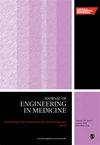物理交联聚乙烯醇水凝胶的溶胀和力学性能
IF 1.7
4区 医学
Q3 ENGINEERING, BIOMEDICAL
Proceedings of the Institution of Mechanical Engineers, Part H: Journal of Engineering in Medicine
Pub Date : 2015-11-24
DOI:10.1177/0954411915615469
引用次数: 45
摘要
物理交联聚乙烯醇凝胶具有良好的生物相容性,是一种用途广泛的生物材料。在过去的几十年里,物理交联聚乙烯醇和聚乙烯醇基水凝胶在生物医学应用方面得到了广泛的研究。然而,由于机械强度的原因,这些材料尚未得到应用。物理交联的聚乙烯醇凝胶由微晶物理交联的聚乙烯醇膨胀的无定形网络组成。虽然在纳米和微观尺度上控制微晶的分布可以在一定程度上改善材料的力学性能,但在保持高含水量的同时提高材料的力学性能仍然是非常困难的。使用传统的制造方法,在保持凝胶的高吸水能力的同时,可能在技术上不可能显著提高其机械性能。这里考虑了物理交联聚乙烯醇凝胶的膨胀和机械性能的物理和化学理解;提出了一些在实际应用中有前景的策略。本文综述了聚乙烯醇水凝胶的溶胀性能和力学性能的最新研究进展,该凝胶是一种有潜力的生物医用材料,仅用聚乙烯醇和纯水制备而成。本文章由计算机程序翻译,如有差异,请以英文原文为准。
Swelling and mechanical properties of physically crosslinked poly(vinyl alcohol) hydrogels
Physically crosslinked poly(vinyl alcohol) gels are versatile biomaterials due to their excellent biocompatibility. In the past decades, physically crosslinked poly(vinyl alcohol) and poly(vinyl alcohol)-based hydrogels have been extensively studied for biomedical applications. However, these materials have not yet been implemented due to their mechanical strength. Physically crosslinked poly(vinyl alcohol) gels consist of a swollen amorphous network of poly(vinyl alcohol) physically crosslinked by microcrystallites. Although the mechanical properties can be improved to some extent by controlling the distribution of microcrystallites on the nano- and micro-scales, enhancing the mechanical properties while maintaining high water content remains very difficult. It may be technologically impossible to significantly improve the mechanical properties while keeping the gel’s high water absorbance ability using conventional fabrication methods. Physical and chemical understandings of the swelling and mechanical properties of physically crosslinked poly(vinyl alcohol) gels are considered here; some promising strategies for their practical applications are presented. This review focuses more on the recent studies on swelling and mechanical properties of poly(vinyl alcohol) hydrogels, prepared using only poly(vinyl alcohol) and pure water with no other chemicals, as potential biomedical materials.
求助全文
通过发布文献求助,成功后即可免费获取论文全文。
去求助
来源期刊

CiteScore
3.60
自引率
5.60%
发文量
122
审稿时长
6 months
期刊介绍:
The Journal of Engineering in Medicine is an interdisciplinary journal encompassing all aspects of engineering in medicine. The Journal is a vital tool for maintaining an understanding of the newest techniques and research in medical engineering.
 求助内容:
求助内容: 应助结果提醒方式:
应助结果提醒方式:


